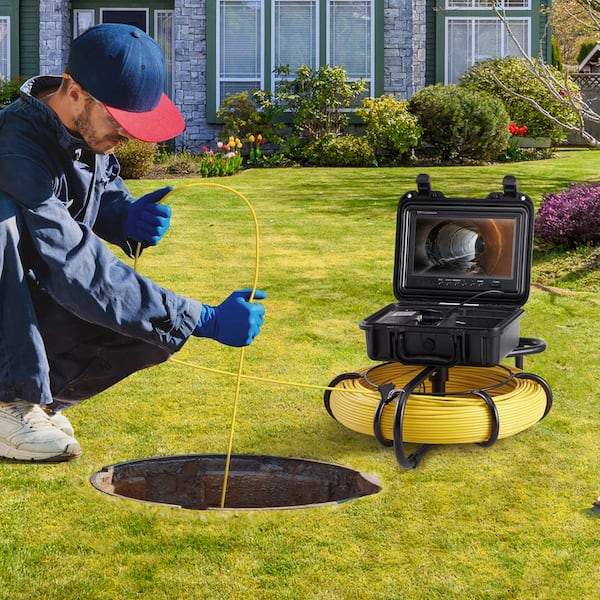
Image Source: Google
In today's world, technology continues to advance at a rapid pace, offering new and innovative ways to explore and understand the world around us. One such technology that is revolutionizing the way we inspect and maintain underground structures is the pipe inspection camera.
These powerful tools allow us to unlock hidden depths and gain valuable insights into the condition of pipes, sewers, and other hard-to-reach areas. In this article, we will delve into the world of pipe inspection cameras service, exploring their uses, benefits, and the impact they are having on various industries.
The Technology Behind Pipe Inspection Cameras
Pipe inspection cameras are sophisticated devices equipped with high-resolution cameras and powerful lighting systems that allow operators to capture clear, detailed images of the inside of pipes and other underground structures. These cameras are typically attached to flexible rods or cables, which can be extended deep into pipes to capture footage in real-time. The images and videos captured by pipe inspection cameras can then be viewed on a monitor or recorded for further analysis.
Key Components of a Pipe Inspection Camera
- High-resolution camera: Captures clear, detailed images of the inside of pipes
- Powerful lighting system: Illuminates dark spaces for better visibility
- Flexible rod or cable: Allows the camera to be extended deep into pipes
- Monitor: Displays real-time footage for immediate inspection
Uses of Pipe Inspection Cameras
Pipe inspection cameras have a wide range of applications across various industries. Some of the common uses of these cameras include:
1. Plumbing Maintenance
One of the primary uses of pipe inspection cameras is in the field of plumbing maintenance. These cameras allow plumbers to inspect the inside of pipes for clogs, cracks, leaks, and other issues without the need for costly and invasive excavation. By identifying problems early on, plumbers can perform targeted repairs, saving time and money in the long run.
2. Municipal Sewer Systems
Pipe inspection cameras are also widely used to inspect municipal sewer systems. By conducting regular inspections with these cameras, municipalities can identify and address potential issues before they escalate into major problems. This proactive approach helps to prevent costly repairs and minimize the risk of sewer backups and overflows.
3. Industrial Inspections
In industrial settings, pipe inspection cameras are used to inspect the integrity of pipelines, tanks, and other critical infrastructure. These cameras can help identify corrosion, blockages, and other issues that could compromise the safety and efficiency of industrial processes. By conducting regular inspections with pipe inspection cameras, industrial facilities can ensure compliance with regulations and maintain their operations smoothly.
Benefits of Using Pipe Inspection Cameras
The use of pipe inspection cameras offers numerous benefits to businesses and industries. Some of the key advantages of using these cameras include:
1. Cost-effective Inspections
By using pipe inspection cameras, businesses can conduct thorough inspections of underground structures without the need for excavation or costly downtime. This can result in significant cost savings by identifying and addressing issues before they escalate into major problems.
2. Improved Efficiency
Pipe inspection cameras allow operators to quickly and accurately assess the condition of pipes and other structures, enabling them to take prompt action to address any issues that are identified. This can help businesses streamline their maintenance and repair processes, leading to increased efficiency and productivity.
3. Enhanced Safety
Traditional methods of inspecting underground structures can be dangerous and labor-intensive. By using pipe inspection cameras, operators can avoid the need to enter confined spaces or work in hazardous conditions, reducing the risk of accidents and injuries.
The Future of Pipe Inspection Cameras
As technology continues to evolve, the capabilities of pipe inspection cameras are also advancing. Future developments in this field may include:
1. Integration with AI and Machine Learning
By integrating pipe inspection cameras with artificial intelligence and machine learning algorithms, operators may be able to automate the analysis of footage and quickly identify potential issues. This can help businesses make more informed decisions and prioritize maintenance tasks based on the severity of the problem.
2. Enhanced Connectivity and Data Sharing
Future pipe inspection cameras may feature enhanced connectivity options that allow operators to share real-time footage and data with off-site experts for remote troubleshooting and analysis. This can help businesses access specialized expertise and make faster decisions to address critical issues.
3. Miniaturization and Portability
Advancements in camera technology may lead to the development of smaller, more portable pipe inspection cameras that can navigate even tighter spaces and provide access to a wider range of underground structures. This can expand the capabilities of these cameras and make them even more versatile for various applications.
Overall, pipe inspection cameras are powerful tools that are transforming the way we inspect and maintain underground structures. By leveraging the capabilities of these cameras, businesses and industries can unlock hidden depths and gain valuable insights into the world beneath us.

